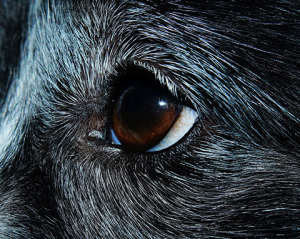First things first – get him down to us to check it out! Dogs’ eyes are delicate, and it’s really important that we’re able to treat any injuries quickly… 
Why do dogs get scratched eyes?
Any object that is either hard or sharp will scratch the cornea (the front layer of the eye) – grass blades, thorns or brambles, a cat’s claws, etc. As a result, this type of injury is known as a corneal ulcer or corneal laceration. The most common cause is running through thick undergrowth or grass and not blinking quite fast enough! It’s also fairly common for a grass seed, a blade of grass, or even a clump of hair to become trapped underneath the eyelid, causing scratches every time the eyeball moves.
If a dog encounters an aggressive or particularly scared cat, they will often make a swipe with their claws – and may catch the dog’s eyes.
The other big problem is with dogs with protuberant eyes (like Pugs) who cannot extend their eyelids to cover the whole surface of the eye. Inevitably, these dogs are at higher risk of eye injuries!
What are the symptoms of a scratched eye?
The most common signs are:
- Runny eyes
- Redness of the membranes around the eye
- Swollen tissue around the eye
- Milkiness or blueness of the surface of the eye
- Pain and rubbing
- Holding one eye closed
Is there any other condition that can be mixed up with it?
Yes – most commonly dry eye (keratoconjunctivitis sicca), where the eye doesn’t produce enough tears; as a result, the centre of the cornea dries out and cracks or ulcerates.
What will the vet do?
Firstly, we’ll try and find out how severe the injury is. To do that, we may have to sedate the dog, but usually, we can use local anaesthetic to stop it hurting and allow us to examine the eye. Once we’ve had a really good look at the injury and the rest of the eyeball, we’ll use a special dye called fluorescein – this sticks to damaged corneal cells, showing us how wide and how deep the injury is. We can then decide on the best course of treatment.
What can be done about it?
The vast majority of corneal injuries are fairly minor and respond really well to simple treatment. This usually involves a short course of antibiotic eye drops and some painkillers for a week or so. If by the end of this time the injury is healing but not quite gone, we can usually just extend the treatment for another week or so. The reason we use antibiotics is that it’s usually just the infection in the wound that stops it from healing on its own!
Is there anything else you might do?
Additional drugs and treatments are available to encourage healing, most commonly plasma drops. This is a liquid that is extracted from the dog’s own blood (we’ll take some if we need to!) that is full of pro-healing, anti-infection and anti-wound breakdown chemicals; and is applied as an eyedrop. Other options include EDTA drops (which do a similar job) and bandage lenses (soft contact lenses that will protect the eye while it heals).
A really serious laceration of the cornea may require surgery – often a pedicle flap to use part of the lining of the eye as a tissue graft to protect and nourish the injury and allow it to heal.
What if it doesn’t heal in that time?
If the eye doesn’t heal normally, the injury may become an indolent ulcer. In this case, we may perform surgery to encourage healing (such as a grid keratotomy); or use a pedicle flap or graft as above.
It’s very, very unusual to come across a scratched cornea that won’t respond to one or more of the advanced treatments we have available now!
If you think that your dog may have an injured eye, get them to us for a checkup as soon as possible.
